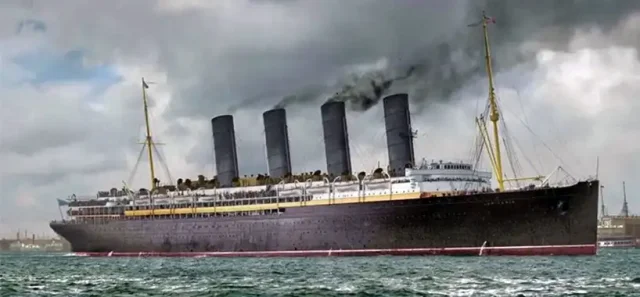- Military History
- Conflicts & Wars
- World War I
- History & Theaters WWI
- World War I - Battle at Sea (1914–1918)
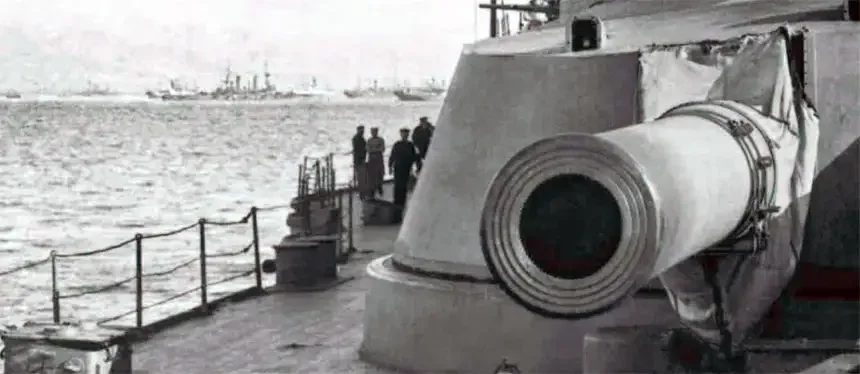
World War I - Battle at Sea (1914–1918) Supply lines under threat
World War I was foremost a conflict fought on land, but it occasioned the largest sea battle in history (Jutland), and the oceans were bitterly contested avenues of supply for the belligerents.
Index of content
- British Naval Objectives
- German Naval Objectives
- The Battle of Helgoland Bight
- The Beginning of U-Boat Operations
- The Diplomatic Cost of Submarine Warfare
- The Battle of Dogger Bank
- Operations of the German East Asiatic Squadron
- Indian Ocean Raids
- Battle of Coronel
- Battle of the Falklands
- War Zone Proclaimed
- The Sinking of the Lusitania
- The Battle of Jutland
- Action after Jutland
- Principal Combatants – Sea Battles of WWI
- Principal Theaters for the Sea Battles of WWI
- Approximate Naval Strength of the Belligerents (1914)
British Naval Objectives
From the beginning of the war, the chief British naval aim was not offensive but the defense of key trade routes. Soon, however, the British instituted a naval blockade of Germany and the other Central Powers, a blockade that increased in strength during the war and proved highly effective.
German Naval Objectives
Some historians have argued that Kaiser Wilhelm II’s (1859–1941) desire to build a German navy rivaling that of Great Britain was a prime cause of World War I. Yet when the war began, Germany deployed its surface vessels in ways intended to avoid a confrontation with the British. Initially, surface craft were used to lay mines in key enemy harbors, and German U-boats (submarines) preyed on Allied merchant ships and Royal Navy vessels, the latter with the purpose of reducing Britain’s numerical superiority.
The Battle of Helgoland Bight
Contrary to its prevailing policy of avoiding offensive action, on August 28, 1914, British light cruisers ventured into German home waters to provoke a fight. German cruisers took the bait and headed for the British intruders, whereupon a battle cruiser squadron under Admiral Sir David Beatty (1871–1936) steamed over the horizon and opened up on the Germans. Four German light cruisers were sunk, and 1,000 German sailors were killed or captured. The British suffered substantial damage to a single ship and lost 35 sailors.
The Beginning of U-Boat Operations
The outcome of the Battle of Helgoland Bight discouraged Germany from sending its outnumbered surface fleet beyond its home waters. However, German U-boat operations were begun, and a program of submarine construction was rushed ahead.
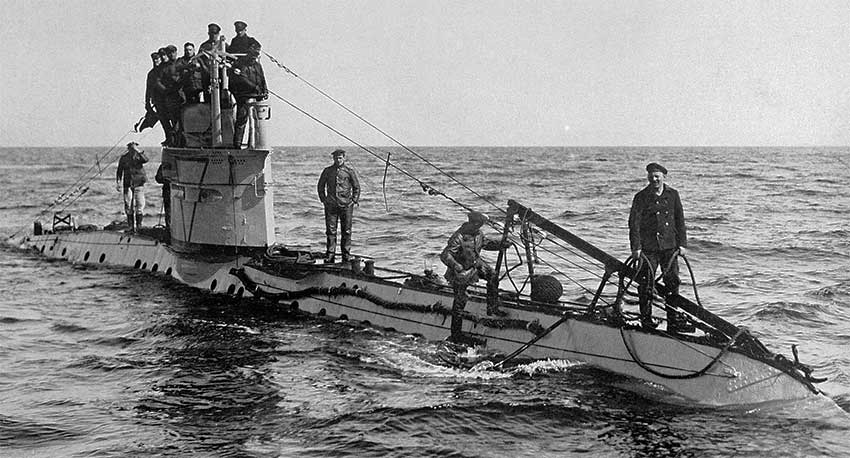
On September 22, U-9, operating off the Dutch coast, sank three British cruisers, the Aboukir, Hogue, and Cressy, in the space of one hour. It was a staggering loss for the British, and a U-boat attack on the anchorage of Loch Ewe, off the west coast of Scotland, followed it on October 7. Several British craft were damaged in their home waters. On October 15, the British cruiser Hawke was torpedoed and sunk. A U-boat raid on Scapa Flow, anchorage of the British Grand Fleet, at the northern tip of Scotland, followed this. Although no British vessels were lost in the raid, the Grand Fleet had to be transferred to an alternate station while they installed submarine nets at Scapa Flow.
The Diplomatic Cost of Submarine Warfare
Prewar international conventions, to which Germany was party, as well as informal naval usage, dictated that U-boats surface, give warning, and allow passengers and crew to abandon ship before attacking a merchant vessel. Sometimes German U-boat commanders respected this convention; however, early in the war, Germany declared Allied home waters a war zone and warned that all vessels in these waters were subject to attack without warning.
Among the neutral nations, especially the United States, the policy of “unrestricted submarine warfare” increasingly turned public opinion against Germany. Although the U- boat was highly effective against Allied shipping (less so after they adopted the convoy system in 1917–18), it courted diplomatic disaster and helped to bring the United States into the war against Germany.
The Battle of Dogger Bank
At the end of 1914, German Admiral Franz von Hipper (1863–1932) resolved to venture out-of-home waters with the battle cruisers of the German High Seas Fleet for a lightning run across the North Sea to raid the British coast. Hipper bombarded Scarborough and Hartlepool, inflicting many civilian casualties before he returned to home port.
The success of the raid encouraged Hipper to make another sortie in January 1915, but they intercepted his fleet on January 24 at Dogger Bank, midway between England and Germany. Royal Navy intelligence had intercepted German radio signals, and Admiral Beatty was prepared with five battle cruisers to meet Hipper’s three (various lighter vessels accompanied both squadrons).
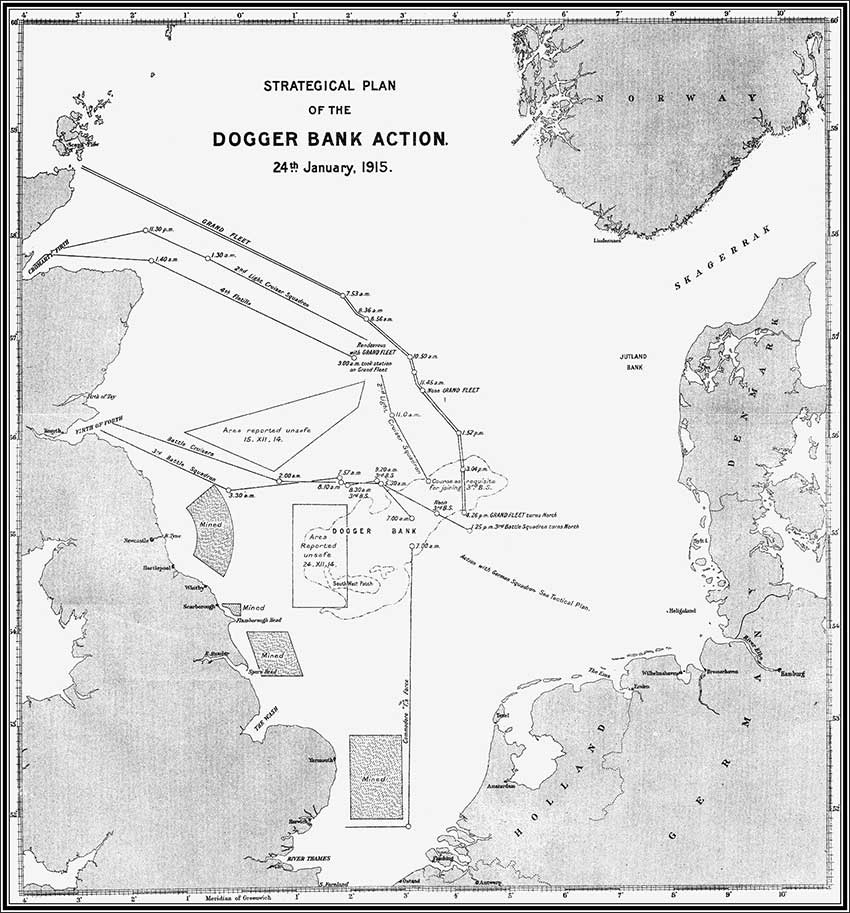
Outnumbered, Hipper attempted to flee, but Beatty overtook him, sinking the cruiser Blücher and damaging the two other cruisers, including the admiral’s flagship, Seydlitz. After Beatty’s own flagship, Lion, was hit, a break-down in ship-to-ship communication brought a premature end to the attack, which permitted Hipper to get away. This was a disappointment for the Royal Navy, but Dogger Bank resulted in an order from the Kaiser himself instructing naval commanders to avoid all further risk of losing major surface ships.
Operations of the German East Asiatic Squadron
The German East Asiatic Squadron, commanded by Admiral Graf Maximilian von Spee (1861–1914), was assigned to defend Germany’s Pacific colonial holdings. The squadron was equipped with modern, fast cruisers, including the heavy cruisers Scharnhorst and Gneisenau, and the light cruisers Nürnberg, Emden, and Leipzig. During the first four months of the war, from August through November 1914, the squadron ravaged merchant shipping on the British trade routes and troopships on their way to Europe or the Middle East from India, New Zealand, and Australia.
Indian Ocean Raids
During August–November 1914, the Emden, under Captain Karl von Müller (1854–1940), was detached from the East Asiatic Squadron and sent to the Indian Ocean, where it sank several merchant vessels in the Bay of Bengal, bombarded Madras, India (September 22), and disrupted traffic in the approaches to Ceylon (Sri Lanka). On November 9, the Australian cruiser Sydney attacked Emden, which was scuttled off the Cocos Islands (Keeling Islands) to avoid capture. By this time, Emden had sunk 15 Allied ships.
Battle of Coronel
Simultaneously, with the Emden’s operations in the Indian Ocean, the rest of the East Asiatic Squadron steamed toward the Chilean coast. Spee was unaware that Admiral Sir Christopher Cradock (1862–1914), commanding two obsolescent armored cruisers, Monmouth and Good Hope, and one light cruiser, Glasgow, besides Otranto, an armed merchant ship, had been assigned to hunt down the East Asiatic Squadron.
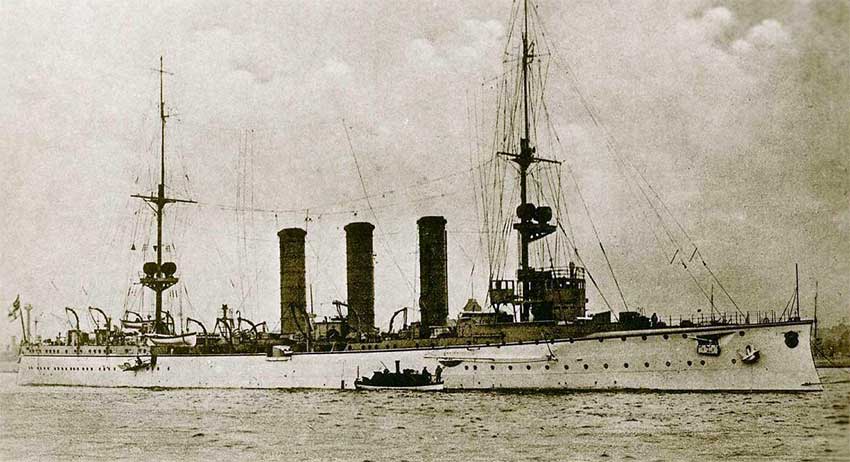
The two squadrons clashed at Coronel, off the southern coast of Chile, on November 1, 1914. Although the British and German forces were evenly matched, the much newer German ships outgunned the older British vessels, and Spee could fire from beyond the range of the British guns. The two British heavy cruisers sank with all hands, including Admiral Cradock; only Glasgow and Otranto escaped.
Battle of the Falklands
Encouraged, Spee sailed for Port Stanley in the Falkland Islands, to raid the British wireless facilities and coaling stations there. Spee was unaware that a British squadron, including the battle cruisers Invincible and Inflexible and six other cruisers, all under the command of Vice Admiral F. D. Sturdee (1859–1925), was taking on coal there.
The German admiral attacked on December 8, 1914, and Sturdee responded vigorously. Scharnhorst, with Spee on board, was sunk first, followed by Gneisenau, Nürnberg, and Leipzig. This time it was the British ships that enjoyed the advantage of bigger guns and could therefore fire from beyond the range of the Germans. The British sailors suffered a mere 25 casualties (none fatal) whereas 1,800 German sailors went down with their ships.
Of Spee’s squadron, only the light cruiser Dresden escaped. Three months after the Falklands battle, they intercepted it off the Juan Fernández Islands on March 14, 1915. Its captain gave the order to abandon ship and scuttled her to prevent capture. The Battle of the Falklands ended commerce raiding by German surface vessels.
War Zone Proclaimed
Although the German surface fleet had suffered serious blows, the submarine forces continued to prey upon high seas commerce. On October 20, 1914, the British merchant steamship Glitra was torpedoed, and many other sinkings followed. On February 4, 1915, came the German proclamation of a war zone in the waters around the British Isles. In this area, merchant ships, including those of neutral nations, such as the United States, were subject to attack without warning.
U-boats could sink seven out of 11 Allied vessels attacked in the first week of the 1915 “war zone” campaign. It was an impressive record, but Germany had only a few U- boats. In March 1915, approximately 6,000 Allied sailings were recorded. Of this number, 21 ships were sunk. Far more effective against merchant shipping was the ongoing British blockade of Germany. During 1915, over 3,000 vessels were intercepted and inspected, and outbound trade from Germany was entirely halted.
The Allies also rushed to develop antisubmarine warfare techniques, including antisubmarine nets to block harbors, and so called Q-ships, heavily armed vessels disguised as merchant steamers.
The Sinking of the Lusitania
On May 7, 1915, the British liner Lusitania, bound from New York to Liverpool, was torpedoed and sunk. Of almost 2,000 civilian passengers, 1,198 died, including 128 U.S. citizens. The incident irreparably damaged U.S.- German relations.
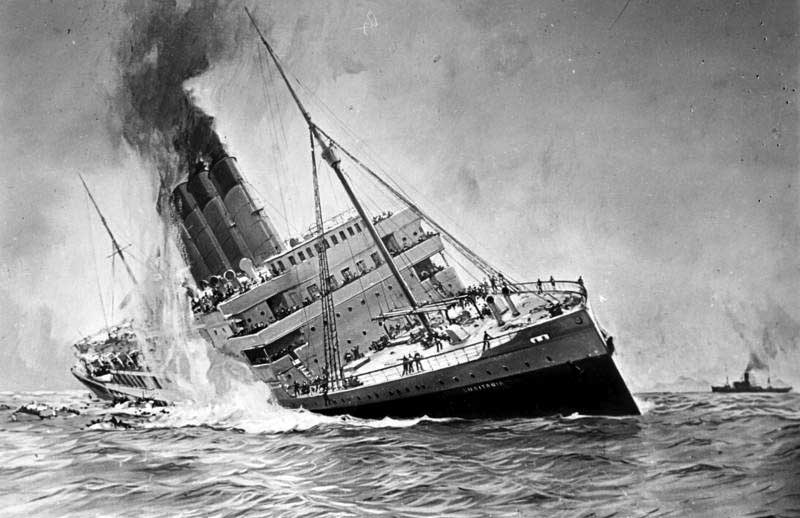
On August 17, another British passenger ship, the Arabic, was sunk, with more loss of American lives. On September 18, the Hesperia was torpedoed and sunk. But with the threat of U.S. entry into the war, Germany agreed to suspend U-boat activity in the English Channel and west of the British Isles.
The Battle of Jutland
In January 1916, Vice-Admiral Reinhard Scheer (1863–1928) was put in command of Germany’s High Seas Fleet and attempted a new breakout of the surface vessels. He planned to provoke battle on the open sea between the entire German High Seas Fleet and some smaller portion of the British fleet. The German navy was outnumbered, but if he could engage only a portion of the British fleet, Scheer would enjoy a temporary superiority of numbers. He might score a glorious victory and significantly reduce the strength of the British navy. This would relieve some of the pressure of the British blockade.
Scheer’s chosen target was Beatty’s battle cruiser squadron at Rosyth, halfway up Britain’s eastern coast. Scheer proposed to attack and destroy the squadron before reinforcements from the Grand Fleet’s principal base at Scapa Flow, off the northern tip of Scotland, could arrive. As bait to lure Beatty, Scheer ordered five battle cruisers, the First Scouting Group, together with four light cruisers, the Second Scouting Group, to sail north under the command of Vice Admiral Franz von Hipper from Wilhelmshaven, Germany, to a point off the southwestern coast of Norway.
Scheer, commanding the battle squadrons of the main High Seas Fleet, was to follow 50 miles behind and trap Beatty’s ships between the High Seas Fleet and the First and Second Scouting Groups. Unfortunately for the Germans, British naval intelligence intercepted radio traffic relating to the operation, and on May 30, 1916, the entire British Grand Fleet set off for Norway’s southwestern coast.
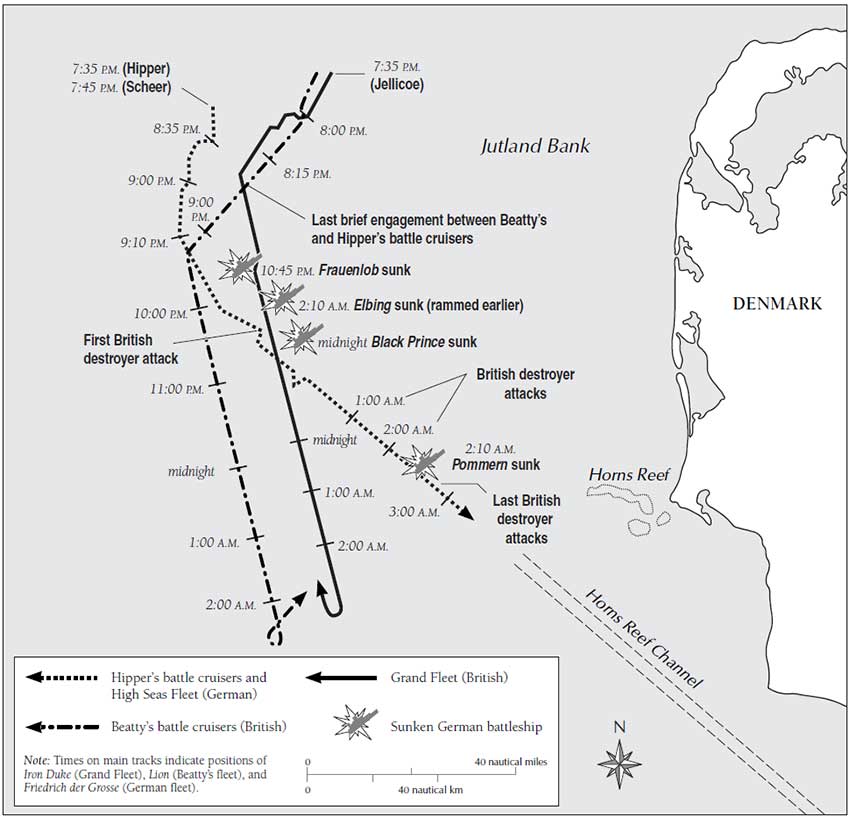
The forces involved were large, the greatest number of ships ever directly involved in a single battle. Admiral Scheer led 99 vessels into battle, including 16 dreadnoughts and six pre-dreadnought battleships, five battle cruisers, 11 light cruisers, and 61 destroyers. British admirals Sir John Jellicoe (1859–1935) and Beatty commanded 151 ships, although many were of older design than the German vessels. Their command included 28 dread- noughts, nine battle cruisers, eight armored cruisers, 26 light cruisers, five destroyer leaders (heavy destroyers), and 73 standard destroyers, as well as a minelayer and a seaplane carrier.
At 2:20 on the afternoon of May 31, Beatty’s advance guard of light cruisers spotted the German light cruisers and opened fire. Hipper turned back toward the German main fleet, and Beatty paralleled his course. Beatty also signaled Admiral Hugh Evan-Thomas (1862–1928), in command of a squadron of four new super-dreadnoughts, to follow. In the meantime, the two battle-cruiser forces opened fire on one another at a range of 16,500 yards.
The German guns were bigger and their gunnery more accurate than the British. Within less than an hour Beatty’s flagship, the Lion, as well as the Princess Royal, Tiger, and the more lightly armored battle cruisers Indefatigable and the Queen Mary, were sunk. Although the German ships Seydlitz, Derflinger, and Lutzow were badly hit, they left Beatty with only four ships against Hipper’s five. Though recognizing the superiority of the German guns at long range, Beatty ordered his remaining ships to engage the enemy more closely.

As Beatty and Hipper continued to fight, Hipper sighted the super-dreadnoughts of Evan-Thomas’s Fifth Battle Squadron A, and the fighting became even more intense. Queen Mary exploded and sank at 4:26 P.M., and at about this time the British Second Light Cruiser Squadron sighted Scheer’s battleships. Jellicoe’s primary force was converging on these. But Evan-Thomas’s super-dreadnoughts took severe hits from Scheer’s approaching battleships.
At the head of the main British fleet was the Third Battle Squadron (three battle cruisers and two light cruisers) commanded by Rear Admiral Sir Horace Hood (1870–1916). Hood vigorously engaged Hipper’s cruisers and destroyers, and at 6:34 his flagship took a direct hit, exploded, and sank, carrying with it the admiral and all hands. Two British cruisers, Defence and Warrior, were also sunk.
Despite devastating losses, the British Grand Fleet was now in a powerful position across the front of the German High Seas Fleet. It had “crossed the T,” bringing to bear the bulk of its guns against Scheer’s fleet, which, facing the British broadside head on, could employ far fewer guns and was therefore at a great disadvantage.
Admiral Jellicoe exploited his hard-won advantage, battering the German ships, which, however, proved remarkably strong and withstood the onslaught well. Scheer’s stalwart vessel, coupled with his brilliant seamanship, allowed him to execute a 180-degree “battle turn,” which took him out of the range of most of the British fleet.
But Scheer was not through. Executing another 180- degree turn, he steamed back toward Jellicoe’s fleet in the belief that Jellicoe had divided his forces. The assumption proved to be a serious error. Scheer found himself under the guns of the entire British force, Jellicoe having yet again crossed Scheer’s T. The end of the German High Seas Fleet seemed to loom, but Scheer refused to give up. He sent four German battle cruisers charging into the British line in what was later termed a “death ride.” All four of the vessels were severely damaged, but they remained in action while German destroyers, masked by a smoke screen, closed in on Jellicoe’s battleships to fire torpedoes.
Had Jellicoe ordered the Grand Fleet to advance through what was now a disorganized array of German battle cruisers, Scheer would have been defeated. Instead, worried that the destroyer torpedo attacks would sink more battleships, he ordered his fleet to turn away, allowing Scheer to withdraw.
Scheer now turned to the southeast, heading directly into the formation of British light cruisers that brought up the rear of Jellicoe’s fleet. From about 9:30 P.M. until 3 A.M., the Battle of Jutland became a melee of intensive gunfire and even collisions. Scheer eventually limped away, eluding Jellicoe’s attempt to isolate him from his port.
Thus, the greatest naval battle in history ended as more or less a bloody draw. We may say that the Germans achieved a tactical victory, having destroyed three British battle cruisers, three cruisers, and eight destroyers, with the loss of 6,274 officers and men, but suffered a strategic defeat.
The Germans lost a battleship and a battle cruiser, besides four light cruisers, five destroyers, and 2,545 officers and men, but, far worse, they had failed to reduce the numerical superiority of the British fleet. The German High Seas Fleet would never again seriously venture out from the security of its home ports. It had been neutralized as an instrument of war.
Action after Jutland
On August 18, 1916, the German High Seas Fleet briefly sortied out of its home waters to meet the British Grand Fleet, but both Admiral Scheer and Admiral Jellicoe withdrew without making contact. Except for minor hit-and-run light-cruiser raids on the British coast, Germany conducted the rest of the naval war with U-boats until the day of the armistice.
After the armistice of November 11, 1918, the German High Seas Fleet was surrendered (November 21, 1918) and interned at Scapa Flow. On May 7, 1919, the skeleton crews manning the fleet learned of the humiliating terms of the Treaty of Versailles: The German navy was to be reduced to 15,000 men, six small battleships, six light cruisers, 12 destroyers, and 12 torpedo boats. All other vessels were to be irrevocably turned over to the Allies.
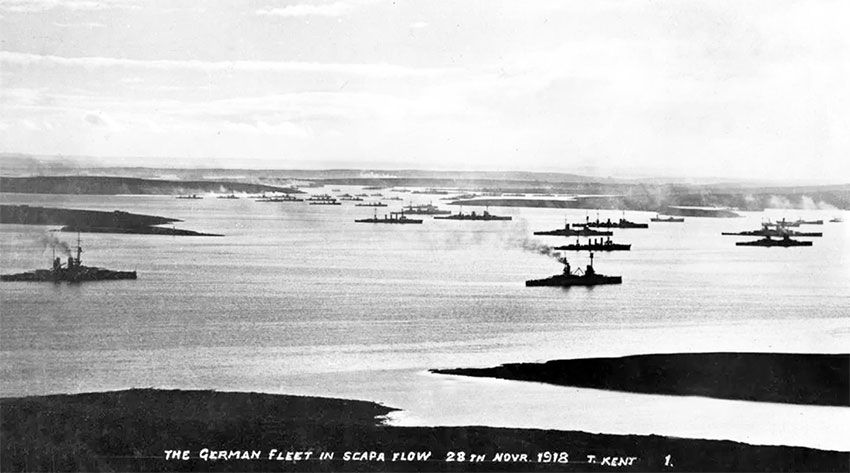
They would not permit the German navy any U-boats, and they also banned German naval aviation. At 11:20 A.M. on June 21, 1919, in defiance of the terms of the Treaty of Versailles, the German crews scuttled the High Seas Fleet where it lay at anchor. Before British vessels could respond, 52 ships were lost. The British saved 22 others.
Principal Combatants – Sea Battles of WWI
The navies of Great Britain and the United States vs. the German navy were the principal combatants at sea. See World War I: Western Front (1914–18) for a complete list of belligerents.
Principal Theaters for the Sea Battles of WWI
North Atlantic, North Sea, Indian Ocean, Pacific Ocean (off east Asia); Coronel and Falkland Islands, off the South American coast.
Approximate Naval Strength of the Belligerents (1914)
- Dreadnoughts: Britain, 20; Germany, 13
- Battle cruisers: Britain, 8; Germany, 5
- Pre-dreadnoughts: Britain, 40; Germany, 22
- Cruisers: Britain, 102; Germany, 41
- Destroyers: Britain, 301; Germany, 144
- Submarines: Britain, 78; Germany, 30
Sources & further reading
- Geoffrey Bennett, Naval Battles of the First World War (New York, Penguin, 2002)
- Tony Bridgland, Sea Killers in Disguise: The Story of the Q-Ships and Decoy Ships in the First World War (Annapolis, Md., Naval Institute Press, 1999)
- A. A. Hoehling, The Great War at Sea (New York, Barnes and Noble, 1995)
- Bernard Ireland, War at Sea 1914–1945 (New York, Sterling, 2000)
- Charles W. Koburger and Paul G. Halpern, The Central Powers in the Adriatic, 1914–1918: War in a Narrow Sea (Westport, Conn., Greenwood, 2001)
- Barrie Pitt, Coronel and Falkland: Two Great Naval Battles of the First World War (London, Cassell, 2002)
- {{#owner}}
- {{#url}} {{#avatarSrc}}
{{name}} {{/url}} {{^url}} {{#avatar}} {{& avatar}} {{/avatar}} {{name}} {{/url}} - {{/owner}} {{#created}}
- {{created}} {{/created}}


